-crops burn, losses mount
As current El Niño weather conditions persist, rice farmers along the West Coast of Demerara have already suffered huge losses, while others remain optimistic that their crops will survive the dry spell.
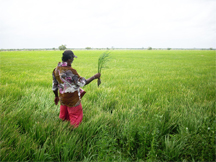
Stabroek News visited several rice fields in the West Demerara area yesterday, in order to obtain a first hand view of the effects of the weather phenomenon on the current rice crop. Rice farmers in the area told this newspaper that the dry spell has left many of them counting heavy losses.
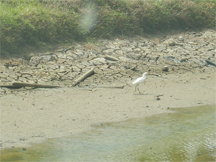
One rice farmer from Crane, West Coast Demerara told this newspaper that he has left the outcome of his crop to the almighty, since there is no other feasible way to obtain water but for the rains to come. He said that he has a three acre crop on the northern eastern side of the Crane Public Road and according to him water is hard to come by.
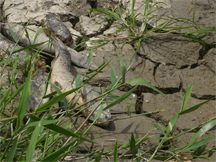
He said that he uses water from a nearby trench, which is pumped into the rice fields close to his home using tractor-driven pumps. The man, who along with other farmers asked not to be named, took Stabroek News to rice fields in Harlem/Crane and Vreed-en-Hoop.
The Vreed-en-Hoop rice farmers related that many of them have already given up their crops and they are concerned about the significant losses they have had to face and the prospects of being reimbursed for their losses. The Ministry of Agriculture stated in a release recently that as part of the interventions made to assist farmers along the Coastland, every effort is being made to mitigate losses in the vicinity of $3B worth of crops and livestock that is in danger.
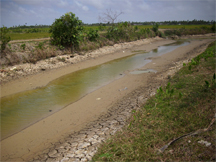
Another rice farmer told Stabroek News yesterday that he has planted some 25 acres of rice this crop, which is expected to mature around March month end. He said that his crop is currently at the 70 day stage and requires water through most of its cultivation. He said that as his crop matures to reach the 90-day reaping stage, it is left to the heavens to bring water to his rice fields.
The man explained that he has invested approximately $60,000 for each acre of his crop and the entire crop to date costs some $2M. He said the benefits of the crop, given the current conditions, is difficult to imagine at this point. He has already begun to see losses coming his way.
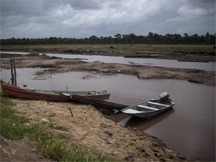
The rice farmers yesterday took Stabroek News through their fields where many crops have started to “burn,” according to the farmers. Several rice lands, normally characterised by thick slush or swamp, as the rice plant thrives under those wet conditions, were dry in most parts to the extent that huge cracks were visible on the ground beneath the rice plants. Several acres of the staple plant were dried out in the centre of the allocated plots and the farmers said that with the limited water available, the water currently utilised is only able to reach the outer sections of the field. Persistent sunlight during the day has added to the already dreadful effects the rice fields have been experiencing.
The farmers also noted that this crop, called “the small crop,” utilises smaller paddy for cultivation and it results in a better yield. The current crop is expected to mature for reaping in March /April, at the end of the required three-month timeline for the plant’s lifetime. The May/June crop, called “the big crop,” usually matures around September and according to the farmers, it brings in an average yield in terms of returns.
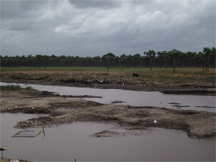
As Stabroek News travelled around the area, a cash crop farmer in the Vreed-en-Hoop area told this newspaper that his crop, which is utilised for household consumption, has seen batter days where availability of water is concerned. He said that he has already felt the effects of losses encountered from the limited availability of water for his crops and he was hopeful that weather conditions may change. As the man spoke to this newspaper, he poured water into a contraption which he set up adjacent to his farm plots to feed water to his plants. He said “on a normal day” water is usually available by way of the trenches nearby.
Stabroek News also visited the Boerasirie Conservancy, where according to the National Drainage and Irrigation Authority (NDIA), the present level (53.60 Georgetown Datum-GD) is below the Dead Storage Level (55.50 GD) of the holding area. The conservancy appeared dry in most parts as boats, usually used by farmers and other residents in the area, remained moored along its banks. Several cows were also visible in sections of the conservancy yesterday as they grazed around on available grass.
According to the HydroMet Department, the current El Niño weather conditions are expected to last until April this year, based on current forecast. In the Region Three area, the authorities, including the NDIA, have made several interventions, including excavation works to critical areas and the installation of pumps to several areas to re-circulate water in order to cushion the effects of the dry spell. The El Niño conditions have affected several areas around the country and the main crop producing areas along the coastland have felt the brunt of the weather phenomenon, which according to the HydroMet Department is expected to yield a higher probability of reduced rainfall and dry conditions in the southern most part of Guyana.
President Bharrat Jagdeo has since stated that a national effort is required in response to the dry weather conditions and he has made a commitment to visit several areas across the country, including a visit to the Region Two area this weekend, in order to have a first hand assessment of the situation.




